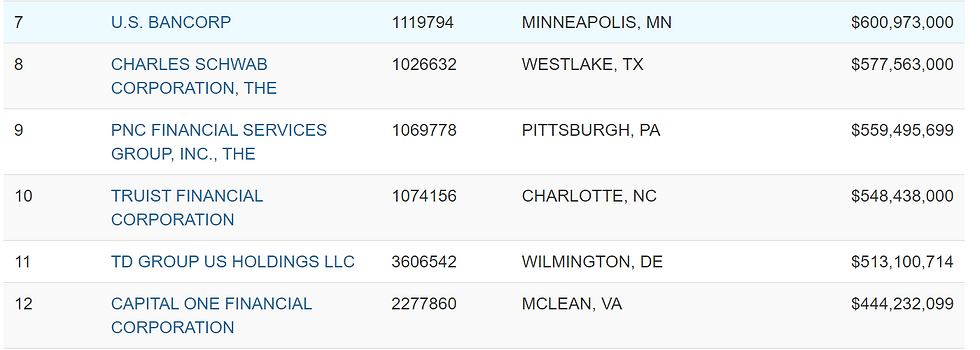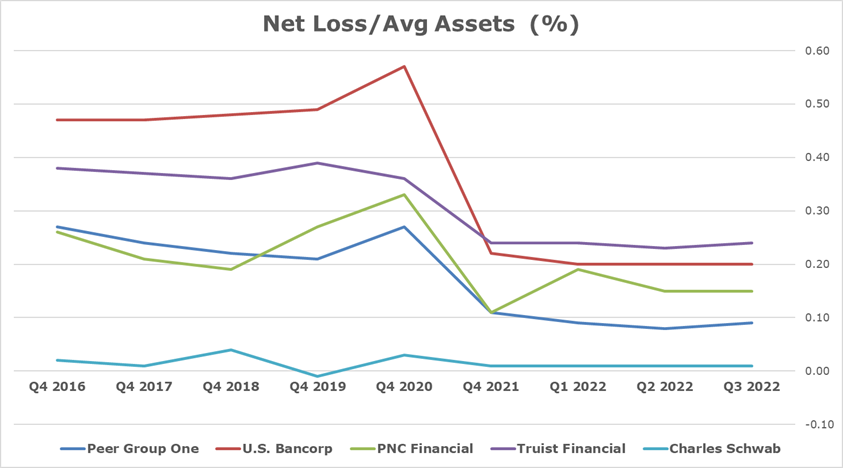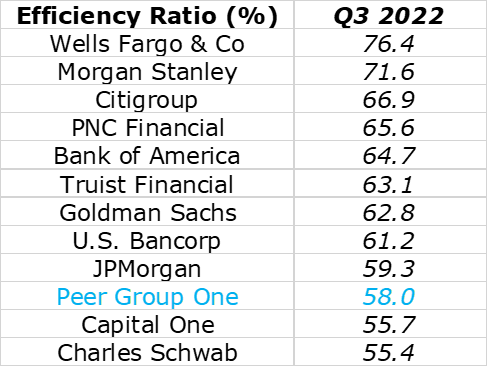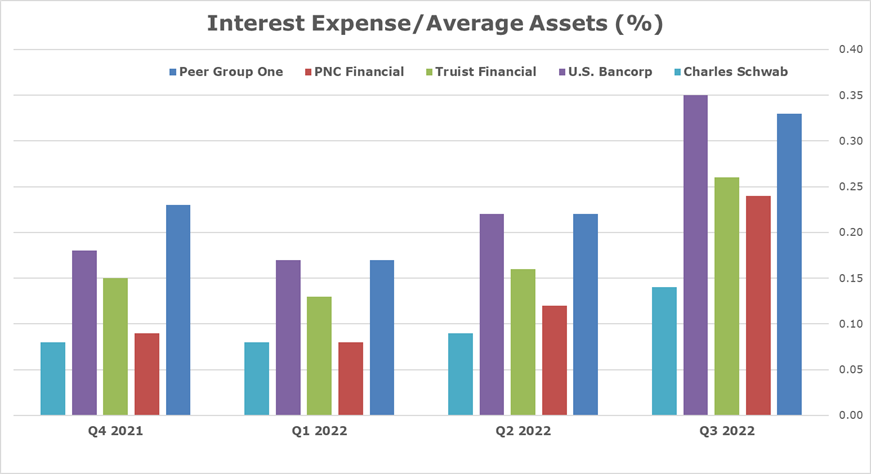Update: Truist, Charles Schwab, U.S. Bancorp & PNC Financial
- Jan 4, 2023
- 7 min read
Updated: Jan 13, 2023
January 4, 2023 | Premium Service | We begin the year 2023 with most financials down for the past year but hardly cheap by historical measures. The largest banks continue to serve as a haven for refugees from crypto fraud schemes and the fintech swoon, but this may be unwise except in limited cases. We anticipate that in the next 24 months financials will give up profits earned over the past two years, with shrinking book values, rising credit expenses and only slow return of earning assets to pre-COVID levels of return.
In the punishing environment created by the FOMC, the largest banks face a difficult road since they absorbed the majority of the reserves pumped into the banking system by Fed bond purchases. As we’ve documented using the data from FDIC, new bank lending was retarded during QE. As a growing number of researchers have noticed, QE may not actually even help the financial markets by increasing general market liquidity. Archarya and Rajan (2022) write:
“In times of stress, the demand for liquidity can significantly rise and liquid commercial banks, desiring to maintain unimpeachable balance sheets, may provide only limited re-intermediation of liquidity and contribute significantly to liquidity shortages.”
Given the prospect of higher interest rates and shrinking liquidity, we ponder the next group of banks below the top four moneycenter institutions, what we have named the “Half Ts” for banks near $500 billion in balance sheet assets. This includes Truist Financial (TFC), PNC Financial (PNC), Charles Schwab (SCHW) and U.S. Bancorp (USB), a group which deserves greater attention from investors and analysts.
We exclude CapitalOne Financial (COF) because it is a monoline credit card issuer better compared to Citigroup (C). We wrote about COF before the New Year (“Outliers: CapitalOne, Goldman Sachs & Citigroup”). We also exclude the US unit of The Toronto-Dominion Bank (TD) at $513 billion in total assets because the relative performance is so poor for this deposit laden, loan poor regional mess.
When will our friends in Canada learn not to buy second-rate community banks south of the border in an effort to build enduring market share? American consumers have no brand loyalty when it comes to banks. Zero. And US consumers are smarter and more aggressive on interest rates and other product features than ever before. Just ask the folks at COF or USB who spend big on customer acquisition and retention.

Since USB is consistently the best performer among the top-five money center banks, the obvious question is whether any of the other half trillion-dollar banks can compete with the $600 billion moneycenter from Minneapolis. Among the larger banks, USB typically has higher credit losses, but employs better operating efficiency to deliver above-peer results. USB is down about 25% over the past year, but is still trading at 1.6x book value as the year begins. This is not cheap, but reflects the refugee mentality affecting many managers who seek shelter in large bank stocks.

Source: FFIEC
As we note above, USB has historically had a higher loss rate than its larger peers and also compared to the next five banks in the group. Notice that all of these institutions saw net charge-offs fall during QE. Now we expect to see this process reversed as the Fed effectively becomes a net seller of bonds and credit. In other words, we look for banks generally to report 2x growth in net credit losses over the next 18 months. In the event, the credit loss numbers are still low by historical measures, but will impact earnings just the same.
Obviously SCHW is the lowest loss institution in the group because the bank really does not take credit risk. The loan book is just over $100 billion of the bank’s $577 billion in assets, including $25 billion in 1-4 family loans. If anything, we’d like to see SCHW take a tad more risk. The table below shows operating efficiency for the largest US banks. Think of efficiency as the cost of revenue, thus a lower number means more of each dollar of revenue falls to the bottom line. Note that SCHW has the lowest efficiency ratio of the group.

Source: FFIEC
Compare this picture at SCHW to TD, which is primarily an investment manager outside the US, but has acquired an under-leveraged regional banking business in the US (“Profile: Toronto Dominion Bank”). TD USA has a small, middle market loan book and above-peer net credit losses, but just 1/3 of the balance sheet is lent out. The other 2/3s of TD USA's $500 plus billion in assets is securities. At 9/30/22, TD had negative $10 billion in unrealized losses on non-portfolio assets. If you perform a conservative mark-to-market on TD USA's retained securities portfolio, the bank is arguably insolvent.
When we turn to the loan book of these institutions, the difference between large and small banks quickly becomes apparent. The comparison of gross spread on loans and leases is led by Peer Group 1, which represents the simple average of the 132 bank holding companies above $10 billion in the peer sample. Smaller banks have been gross loan yields than do larger banks, which are forced to chase larger, less prime assets to fill balance sheets.
Next comes TFC, which is finally emerging from years of operational problems involved with the merger of BB&T with SunTrust Banks. TFC is down 30% over the past year and currently trades around book value in the equity markets. USB comes next, followed by PNC near the bottom of the group and finally SCHW.

Source: FFIEC
During the period of QE, banks saw yields on loans and leases fall by over 1%, driving down both asset and equity returns. As interest rates now rise back towards average levels, gross yields are also rising but not quite as rapidly as funding costs. Outliers such as SCHW still have an enormous advantage in terms of funding. The chart below shows interest expense vs average assets for the group.

Source: FFIEC
The first thing to notice about the chart is that funding costs for USB and Peer Group 1 are rising much faster than for TFC, PNC and of course SCHW. One big reason for this is that USB has seen a dramatic shift from noninterest-bearing deposits, this even as total deposits have grown to over $470 billion. At Q3 2022, USB had $600 billion in assets, a remarkable statement about asset inflation in the industry.
Whereas USB historically managed to keep assets below $500 billion and funding costs below peer, today the demand for returns is pushing up funding costs for most – but not all -- banks. The USB case is driven by acquisitions. Notice that PNC has a substantial funding advantage over the group, but relatively poor pricing on loans. SCHW is still below 15bp cost vs average assets, one of the lowest funding expense lines in the entire industry.
The bottom line is shown with net income to average assets, a measure of the overall financial performance of the members of the group. This chart illustrates the compression of income across the industry during QE, a process that is only starting to reverse as 2023 begins. We expect to see additional improvements in net income in the Q4 2022 results, but the key relationship to watch continues to be rising funding costs vs asset returns, which are net of credit costs.

Source: FFIEC
We should note that the asset returns shown in 2019 were relatively normal, although the FOMC was in the market acquiring securities. Returns fell sharply in 2020 due to the allocation of $60 billion in provisions for future loss. The return of these loss provisions to income resulted in the sharply higher asset returns in 2021. As we have noted in previous missives, 2022-2023 performance measures for US banks are likely to be closer to normal than the preceding several years.
For our money, readers pondering exposure to bank common equity might consider names such as TFC and PNC for the simple reason that they have more room to grow on the upside and less downside risk in terms of Wall Street exposures and sheer size. For many banks, QE was a tax whereby the Fed subsidized debt issuance by the Treasury and saddled banks with useless short-term reserves that the central bank is now taking back.
Meanwhile, the Federal Reserve System itself is insolvent to the tune of several trillion in unrealized losses and the interest rate mismatch on reserves will ensure operating losses for years to come.
Disclosure: L: CVX, CMBS, NVDA, WMB, JPM.PRK, BAC.PRA, USB.PRM, WFC.PRZ, WFC.PRQ, CPRN, WPL.CF, NOVC, LDI, SWCH

The Institutional Risk Analyst is published by Whalen Global Advisors LLC and is provided for general informational purposes only and is not intended for trading purposes or financial advice. By making use of The Institutional Risk Analyst web site and content, the recipient thereof acknowledges and agrees to our copyright and the matters set forth below in this disclaimer. Whalen Global Advisors LLC makes no representation or warranty (express or implied) regarding the adequacy, accuracy or completeness of any information in The Institutional Risk Analyst. Information contained herein is obtained from public and private sources deemed reliable. Any analysis or statements contained in The Institutional Risk Analyst are preliminary and are not intended to be complete, and such information is qualified in its entirety. Any opinions or estimates contained in The Institutional Risk Analyst represent the judgment of Whalen Global Advisors LLC at this time, and is subject to change without notice. The Institutional Risk Analyst is not an offer to sell, or a solicitation of an offer to buy, any securities or instruments named or described herein. The Institutional Risk Analyst is not intended to provide, and must not be relied on for, accounting, legal, regulatory, tax, business, financial or related advice or investment recommendations. Whalen Global Advisors LLC is not acting as fiduciary or advisor with respect to the information contained herein. You must consult with your own advisors as to the legal, regulatory, tax, business, financial, investment and other aspects of the subjects addressed in The Institutional Risk Analyst. Interested parties are advised to contact Whalen Global Advisors LLC for more information.






.png)



Comments